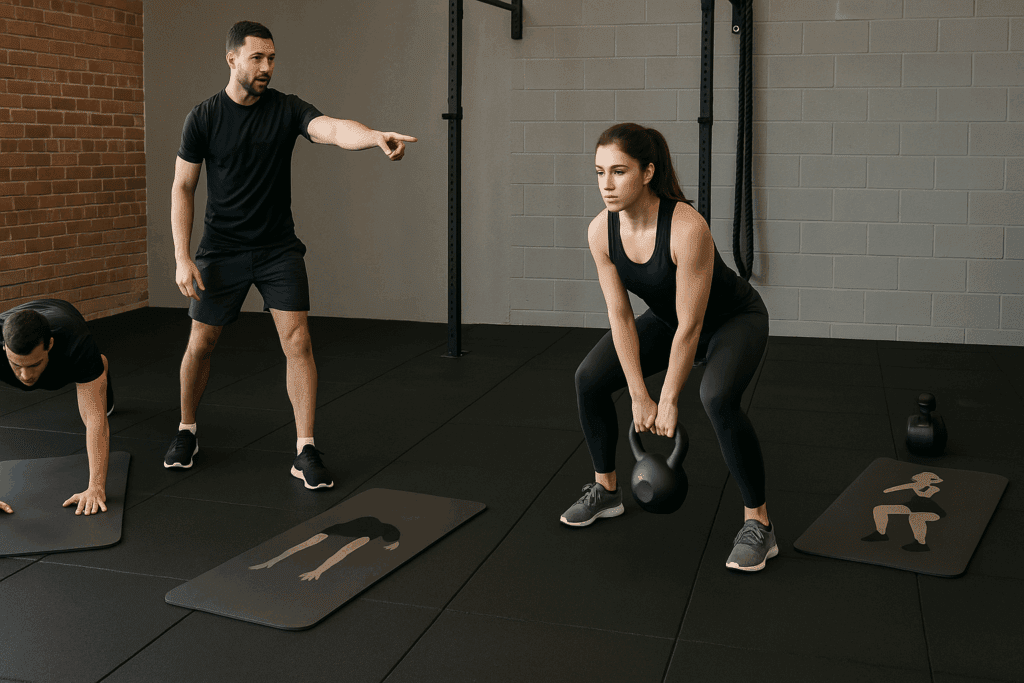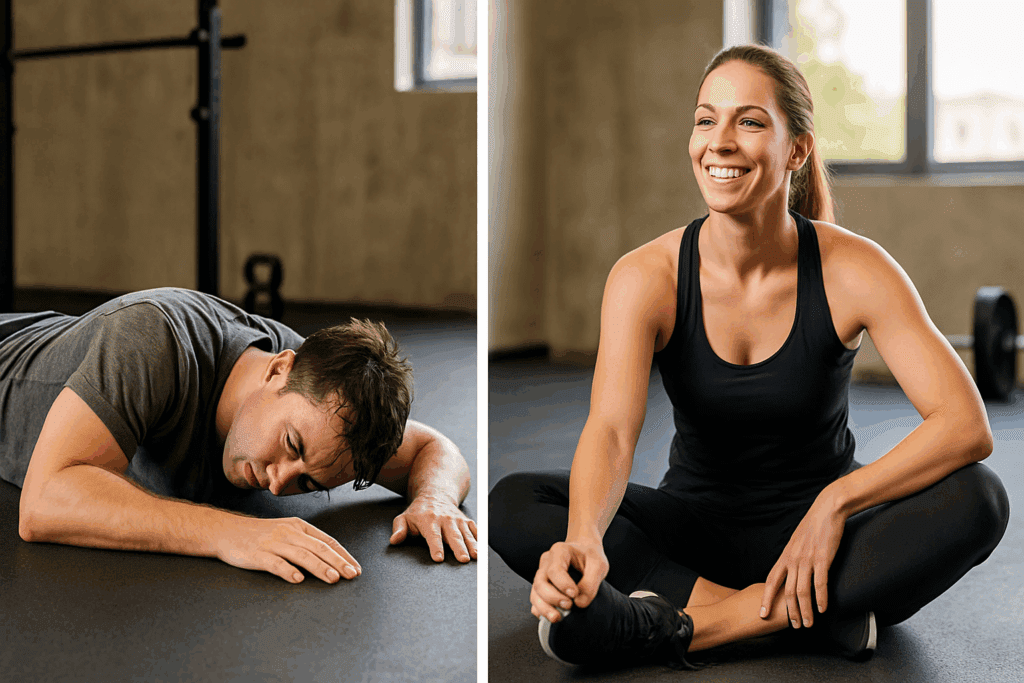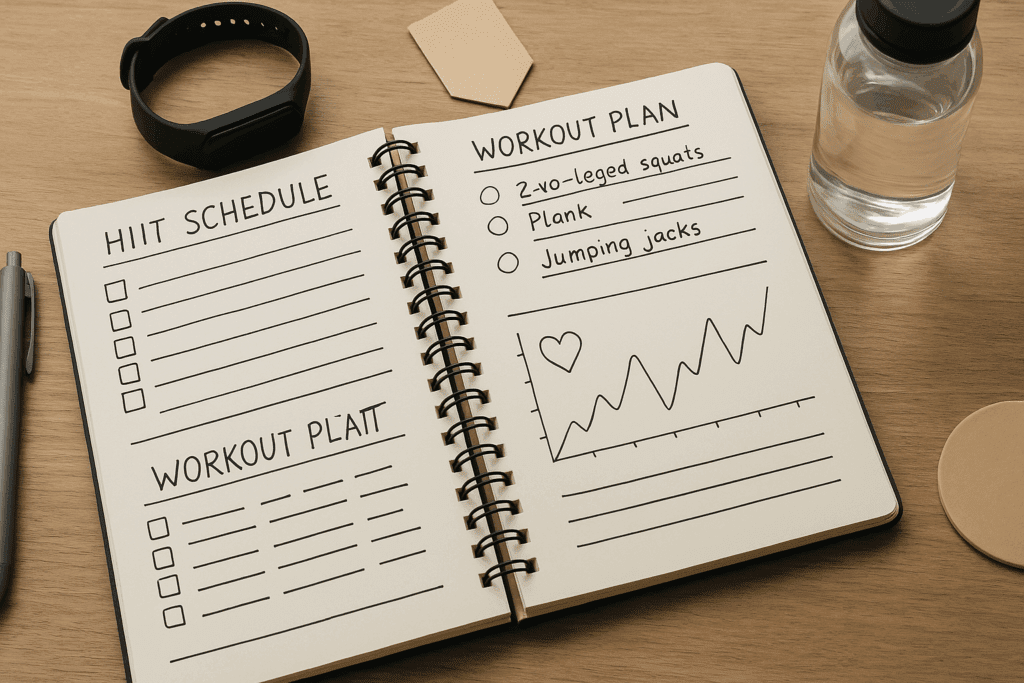Introduction: Unlocking the Power of HIIT for Total Body Transformation
In today’s fast-paced fitness landscape, many individuals are searching for efficient, evidence-based methods to improve health, accelerate fat loss, and enhance performance. High-Intensity Interval Training, commonly known as HIIT, has gained widespread popularity for its ability to deliver exceptional results in a fraction of the time compared to traditional exercise routines. But what makes HIIT training workouts for fat loss so effective, and why is it frequently recommended by fitness professionals and health researchers alike? The answers lie in the physiological impact of intense workouts, the strategic design of HIIT routines, and the lasting metabolic benefits that extend well beyond the gym.
You may also like: How to Increase Stamina and Endurance Naturally: Smart Training Tips and Nutrition Habits That Support Cardiovascular Fitness
Unlike low-intensity steady-state cardio, HIIT involves short bursts of maximum effort followed by brief periods of active recovery or rest. This cycle is repeated several times, creating a metabolic environment that promotes high intensity fat loss and improved cardiovascular endurance. The best HIIT workout for weight loss isn’t just about burning calories during exercise—it’s about igniting a post-exercise afterburn effect, increasing the body’s oxygen demands, and improving efficiency in both anaerobic and aerobic systems. Whether you’re seeking a hard cardio workout to challenge your limits or looking to enhance stamina while sculpting a leaner physique, HIIT offers a compelling, research-supported solution.
This article explores how HIIT training works at the cellular and systemic levels, which routines are best suited for fat burning, and how to implement a sustainable hiit program for fat loss. By applying expert insight and medically accurate principles, we aim to demystify the science of high intensity weight loss and empower readers to make informed, safe, and effective choices in their fitness journeys.

Understanding HIIT: The Science Behind the Sweat
To appreciate the transformative power of HIIT, it’s crucial to understand the underlying science that makes it uniquely effective. High intensity exercise for weight loss challenges the body in ways that conventional cardio cannot. When you engage in all-out effort for intervals ranging from 20 seconds to several minutes, the body rapidly depletes its oxygen stores. This creates a phenomenon known as Excess Post-exercise Oxygen Consumption (EPOC), where the body continues to consume oxygen and burn calories long after the workout has ended.
The metabolic implications of EPOC are significant. In a well-structured hiit workout for weight loss, participants can burn more fat over a 24-hour period than they would with moderate-intensity exercise of equal duration. The body draws from both glucose and fat stores during and after the workout, increasing total energy expenditure. Furthermore, HIIT enhances insulin sensitivity, supports mitochondrial density, and improves VO2 max, all of which are critical factors in long-term cardiovascular health and endurance performance.
Numerous peer-reviewed studies validate the role of HIIT exercises for weight loss and their effect on body composition. For instance, a meta-analysis published in Sports Medicine found that HIIT can reduce total body fat and visceral fat significantly more than steady-state cardio. This underscores why fitness experts often recommend a hiit routine for fat loss for individuals struggling with stubborn abdominal fat.
Moreover, HIIT’s short duration makes it an accessible and sustainable choice for busy professionals or those with time constraints. An intense aerobics workout using HIIT principles can deliver measurable improvements in fitness within just 20 to 30 minutes a few times per week. The effectiveness of these workouts isn’t just anecdotal—it’s grounded in exercise physiology and real-world results.

Building the Best HIIT Workout for Fat Loss
Crafting the best hiit workout for fat loss requires more than random bursts of activity. The workout must be deliberately structured to include a balance of effort, recovery, movement variety, and progression. This ensures that the body remains challenged, adaptive responses are triggered, and the risk of overtraining is minimized.
A prototypical HIIT workout may involve exercises like burpees, jump squats, mountain climbers, kettlebell swings, and high knees. These movements recruit multiple muscle groups, elevate the heart rate quickly, and drive up caloric burn. To enhance effectiveness, fitness professionals often advise alternating between upper-body and lower-body movements. This encourages greater systemic fatigue and ensures a more comprehensive high intensity fat burning workout.
One example of a high intensity fat loss session might include 30 seconds of high knees followed by 30 seconds of rest, repeated eight times. Then, after a short break, continue with 30 seconds of jump squats and 30 seconds of rest. This format can be modified to match different fitness levels, gradually increasing interval time or reducing rest periods for progression. It is also adaptable for both gym and home settings, making it one of the best high intensity workouts for weight loss in terms of flexibility.
Programming variety is key to sustaining interest and avoiding plateaus. Rotating in core-focused intervals or compound strength exercises can elevate the benefits of a hiit program for fat loss by targeting different muscle systems. Similarly, incorporating tools such as resistance bands, medicine balls, or even bodyweight-only options allows for customization that supports individual goals and preferences.

HIIT and Endurance: More Than Just Fat Burning
While HIIT is often celebrated for its ability to burn fat, it also plays a critical role in building endurance and cardiovascular health. Unlike traditional long-duration training that predominantly targets slow-twitch muscle fibers, HIIT recruits both slow- and fast-twitch fibers, leading to comprehensive muscular adaptation. This is particularly advantageous for athletes seeking performance enhancement alongside body composition changes.
The relationship between HIIT and endurance lies in the training’s capacity to raise the lactate threshold. During an intense workout, the body becomes more efficient at clearing lactate and using it as fuel. Over time, this improves the body’s ability to sustain higher intensities for longer periods, translating into enhanced stamina during both short bursts and extended activities.
This adaptation has real-world implications. A well-rounded hiit routine for fat loss can improve a runner’s ability to maintain pace over long distances or help a cyclist handle climbs more efficiently. For recreational athletes, it means better recovery times, greater overall work capacity, and increased motivation from noticeable performance gains. Furthermore, HIIT improves stroke volume—the amount of blood pumped per heartbeat—which contributes to reduced resting heart rate and enhanced oxygen delivery throughout the body.
When integrated strategically into a training plan, hiit training to burn fat doesn’t have to come at the expense of endurance. Instead, it becomes a complementary tool that enhances multiple aspects of physical performance. This synergy between fat loss and endurance optimization highlights why HIIT remains a cornerstone of modern fitness methodologies.

How HIIT Affects Hormones and Metabolism
Beyond its cardiovascular and muscular effects, HIIT exerts significant influence on hormonal health and metabolic function. High intensity weight loss efforts stimulate the release of key hormones such as human growth hormone (HGH), adrenaline, and norepinephrine. These hormones support lipolysis, or the breakdown of fat cells, while preserving lean muscle mass. This hormonal environment favors long-term fat reduction and metabolic efficiency.
Another critical hormone affected by high intensity exercise for weight loss is insulin. HIIT improves insulin sensitivity, enabling better glucose uptake by the muscles and reducing the risk of insulin resistance. This makes it particularly beneficial for individuals with prediabetes, metabolic syndrome, or other glucose regulation issues. Consistent HIIT participation can contribute to balanced blood sugar levels and reduced cravings, further supporting sustainable weight management.
Cortisol, the stress hormone, is also influenced by HIIT. While acute increases in cortisol occur during intense sessions, regular training leads to improved regulation and stress resilience. This means that the body becomes better equipped to handle physical and psychological stressors, contributing to improved overall health and well-being.
Moreover, a thoughtfully designed hiit program for fat loss helps mitigate metabolic slowdown often seen in traditional dieting. Because HIIT preserves muscle mass and elevates resting metabolic rate, it reduces the likelihood of rebound weight gain. The combination of metabolic upregulation and hormonal balance reinforces HIIT’s reputation as a sustainable approach to high intensity fat loss.

Common Mistakes and How to Avoid Them
Despite its benefits, HIIT is not without potential pitfalls. One common error is overtraining, which occurs when individuals perform high intensity workouts too frequently without adequate recovery. This can lead to fatigue, hormonal disruption, injury, and diminished results. The key to sustainable progress is incorporating rest days and lower-intensity activities, such as walking or yoga, between HIIT sessions.
Another frequent mistake is improper exercise selection. Not all movements are appropriate for all fitness levels, and attempting advanced exercises without a foundation in proper form can increase injury risk. Beginners should focus on mastering basic movements and gradually increasing intensity as their strength and coordination improve.
Many also underestimate the importance of warm-up and cooldown routines. Failing to properly prepare the body for a hard cardio workout can lead to muscle strains or joint discomfort. Similarly, skipping cooldowns can impair recovery and reduce flexibility over time. Implementing dynamic stretches, foam rolling, and breath work can significantly enhance the overall effectiveness and safety of HIIT routines.
Lastly, nutrition plays a critical role in supporting high intensity weight loss efforts. Inadequate protein intake, poor hydration, and imbalanced meals can undermine progress and leave individuals feeling depleted. To maximize results, pair your HIIT sessions with nutrient-dense foods that fuel performance, aid recovery, and stabilize energy levels throughout the day.

Designing a Personalized HIIT Program for Success
One of the most empowering aspects of HIIT is its adaptability. Whether you’re a beginner or a seasoned athlete, it’s possible to create a hiit program for fat loss that aligns with your unique goals, preferences, and limitations. Start by identifying how many days per week you can realistically commit to training. For most individuals, three to four HIIT sessions per week strikes a balance between intensity and recovery.
Next, determine your primary objective. If fat loss is the focus, select exercises and intervals that emphasize large muscle groups and maximize calorie burn. If endurance is equally important, incorporate running intervals, cycling sprints, or rowing sessions to improve cardiovascular capacity. For performance enhancement, add elements of plyometrics, agility drills, or resistance-based circuits.
Tracking progress is essential for long-term success. Use metrics such as heart rate response, perceived exertion, weight changes, or improvements in specific exercises to assess whether your routine is yielding results. Don’t hesitate to modify your approach based on these findings. For example, if your progress stalls, consider adding complexity to the workouts or introducing new stimuli like incline training or time-under-tension sets.
Accountability can also make a substantial difference. Joining group classes, hiring a coach, or using fitness apps can provide structure, motivation, and feedback. These tools enhance adherence, promote consistency, and foster a sense of community—all of which are vital for staying on track with a high intensity fat burning workout regimen.
Frequently Asked Questions: Best HIIT Workout for Fat Loss
What is the best time of day to perform a HIIT workout for weight loss?
The best time to perform a hiit workout for weight loss depends on your personal schedule, energy levels, and consistency. While morning workouts may enhance adherence and support metabolic activity throughout the day, afternoon or evening sessions might allow for improved performance due to increased body temperature and flexibility. Regardless of the timing, consistency is more crucial than the clock. To optimize results from your hiit routine for fat loss, ensure you’re well-fueled, hydrated, and mentally prepared. An intense workout performed at a time that fits seamlessly into your lifestyle is far more effective than one squeezed into an inconvenient or energy-depleted part of the day.
Can high intensity fat loss be achieved without equipment?
Absolutely. Some of the best hiit workout for fat loss plans are entirely equipment-free and rely on bodyweight movements that elevate the heart rate quickly. Exercises like burpees, squat jumps, mountain climbers, and plyometric lunges can all deliver a high intensity fat burning workout without needing machines or weights. The key is to structure intervals properly and maintain intensity throughout the session. For those seeking convenience and portability, bodyweight-based hiit training to burn fat offers an accessible and effective method to engage in hard cardio workouts at home or while traveling. Proper form and movement variety ensure continued progress without relying on external resistance.
How does an intense aerobics workout compare to traditional strength training for fat loss?
An intense aerobics workout within a HIIT framework primarily emphasizes cardiovascular exertion, calorie burn, and metabolic acceleration. While strength training focuses more on muscle hypertrophy and progressive overload, it does not always generate the same post-exercise oxygen consumption (EPOC) as a high intensity fat burning workout. However, combining both modalities can create a synergistic effect. For individuals focused on long-term body composition, alternating between resistance days and hiit exercises for weight loss can preserve lean muscle mass while accelerating fat reduction. When programmed correctly, this hybrid approach leads to greater high intensity weight loss without sacrificing muscle tone.
Are there specific dietary strategies that enhance HIIT training workouts for fat loss?
Yes, nutrition plays a pivotal role in amplifying the effects of hiit training workouts for fat loss. Consuming a balanced meal with carbohydrates and protein 60–90 minutes before your session can help maximize energy and performance. Post-workout meals rich in protein and moderate carbs support recovery and muscle repair. Hydration is also crucial—dehydration can impair performance and reduce the efficacy of an intense workout. Additionally, some individuals benefit from training in a fasted state, especially in the morning, although this should be approached cautiously and under guidance. A nutrient-dense, whole-foods-based diet is foundational to making the most of your hiit program for fat loss.
Can HIIT support mental health as well as physical transformation?
Yes, and often in ways that are deeply impactful. Engaging in high intensity exercise for weight loss not only improves physical appearance but also triggers the release of endorphins, serotonin, and dopamine. These neurochemicals enhance mood, reduce anxiety, and create a sense of accomplishment. For many, the mental clarity and confidence that follow an intense aerobics workout can be as valuable as the physical results. The empowering nature of completing a hard cardio workout builds psychological resilience and helps regulate stress. Over time, these mental benefits can encourage consistent participation, ultimately reinforcing both physical and emotional well-being.
How can someone progress from beginner to advanced in HIIT safely?
Progressing safely in a hiit routine for fat loss involves gradual increases in intensity, complexity, and frequency. Beginners should start with basic movement patterns such as bodyweight squats, low-impact jumping jacks, and modified push-ups, focusing on form and joint alignment. As strength and endurance improve, they can introduce more dynamic exercises like jump squats or burpees and reduce rest periods between intervals. Structured programming and listening to the body are vital. Incorporating recovery days and periodically reassessing goals helps prevent overtraining. As participants advance, they may also explore compound lifts or use external resistance to build one of the best high intensity workouts for weight loss tailored to their growing capacity.
Is there an optimal duration for a high intensity fat burning workout?
Most effective high intensity fat burning workouts last between 20 and 30 minutes, including a proper warm-up and cooldown. The brevity of HIIT sessions is one of their greatest advantages, allowing individuals to achieve substantial metabolic benefits in a short time. Going beyond 30 minutes can sometimes lead to diminishing returns, particularly if intensity drops. The goal is to maximize output during each interval, not to prolong the session unnecessarily. For those short on time, even a 15-minute hiit training to burn fat can be remarkably effective when intensity and structure are optimized. Efficiency, not length, determines impact in high intensity weight loss strategies.
What role does recovery play in HIIT-based weight loss efforts?
Recovery is a critical yet often overlooked component of any successful hiit workout for weight loss. During recovery, the body repairs muscle tissue, balances hormones, and replenishes energy stores. Overtraining without adequate rest can lead to chronic fatigue, elevated cortisol levels, and plateaus in fat loss. Incorporating active recovery, such as light walking, yoga, or foam rolling, supports circulation and flexibility. Adequate sleep, hydration, and nutrition are also essential. Without proper recovery, even the best hiit workout for fat loss may yield suboptimal results or increase the risk of injury, ultimately undermining long-term progress.
Can HIIT be adapted for older adults or those with joint concerns?
Yes, with thoughtful adjustments, a hiit program for fat loss can be safe and effective for older adults or those managing joint sensitivity. Low-impact variations of classic moves, such as step-ups, wall sits, or seated punches, allow for cardiovascular intensity without excessive strain. Shorter intervals and longer rest periods can be used to manage fatigue and monitor response. Resistance bands or water-based activities offer joint-friendly alternatives that still promote high intensity weight loss. Consulting a healthcare provider or certified fitness professional ensures the program is personalized and appropriate. With these adaptations, individuals across age groups can experience the benefits of hiit training to burn fat while preserving joint integrity.
What are the signs that a HIIT routine is no longer effective and needs adjustment?
If you’re no longer feeling challenged, have stopped seeing results, or are experiencing persistent fatigue, it may be time to reassess your hiit exercises for weight loss. Adaptation is natural; the body becomes more efficient, and the same stimulus yields fewer benefits. This plateau is a sign that progression is needed, either by increasing intensity, changing the exercise selection, or adjusting rest intervals. Another indicator is lack of motivation or mental burnout, which suggests the need for variety. Rotating in new formats or exploring hybrid approaches—like combining resistance circuits with your hiit workout for weight loss—can reignite progress. A responsive, evolving approach is key to sustaining the benefits of even the best hiit exercises for weight loss over time.
Conclusion: Harnessing the Full Potential of High Intensity Training
High-Intensity Interval Training is far more than just a passing trend—it is a science-backed, versatile, and results-driven method for achieving high intensity weight loss and enhancing overall fitness. From igniting post-exercise calorie burn to improving cardiovascular health and endurance, HIIT delivers on multiple fronts. The best hiit workout for fat loss is not defined by complexity or novelty but by thoughtful programming, consistent effort, and balanced recovery.
Whether you’re pursuing a hiit training to burn fat, build stamina, or simply challenge yourself with an intense aerobics workout, the key is to approach your fitness journey with purpose, patience, and precision. By integrating a well-rounded hiit routine for fat loss into your weekly schedule, you unlock a powerful tool that not only transforms your physique but also elevates your energy, confidence, and resilience.
With a deeper understanding of how high intensity exercise for weight loss works, and how to avoid common missteps, you can embrace HIIT as a sustainable and rewarding part of your lifestyle. It’s not about chasing perfection—it’s about showing up, pushing your limits, and steadily progressing toward a healthier, stronger version of yourself. Let this be the year you harness the full potential of HIIT, and experience firsthand why it’s considered one of the best high intensity workouts for weight loss available today.
Was this article helpful? Don’t let it stop with you. Share it right now with someone who needs to see it—whether it’s a friend, a colleague, or your whole network. And if staying ahead on this topic matters to you, subscribe to this publication for the most up-to-date information. You’ll get the latest insights delivered straight to you—no searching, no missing out.
Further Reading:
10 Best HIIT Cardio Workout for Weight Loss

